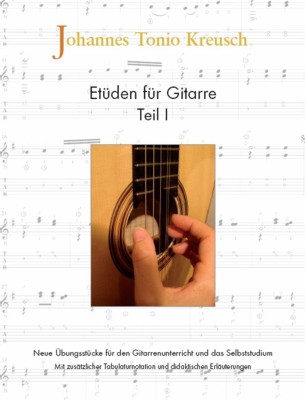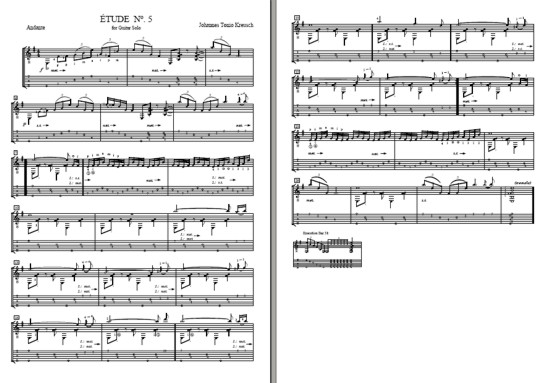Sheet music: Etudes for guitar

New practice pieces for guitar lessons and self-study. With additional tablature notation and didactic explanations by Johannes Tonio Kreusch.
The etudes booklet, which will be continued in further volumes, was born out of an effort to take into account the questions and problems that I encounter time and again in the guitar, and thus to create new practice and teaching material that introduces the student to a conscious and independent examination of the multi-layered possibilities of the guitar.
In a kind of workshop character, elementary basic questions, such as stop technique, vibrato, legato or layer change, as well as rather neglected aspects in the classroom, such as the development of self-creativity through improvisation alimony and composition exercises, crossstring ornamentation or tonal color design, are taken into account.
Order via: info(at)johannestoniokreusch.com
The famous Spanish guitarist Andrés Segovia once compared the guitar to an orchestra, which is seen through a telescope held upside down. This miniature orchestra with all its timbres and playing possibilities must be discovered. The present etude would like to give suggestions on this.
The guitar sounds very different when the right hand plucks the strings in different places. Very close to the bridge, the sound sounds almost metallic. Therefore, the Italian word “metallico” (or “sul ponticello”, which means “near the jetty”) has been used as a term for this way of playing. Above or near the fretboard (italian. “sul tasto” or “sulla tasteria”) sounds a very soft tone. By “naturale” or “ordinario” the usual hand position position above the sound hole is meant. In the available music text I gave you some suggestions for the design of the piece with the different timbres. You can also let your imagination run wild and go on a sound-color discovery journey.
Often the melodic-harmonical connections or the construction of a piece already provide first ideas on how to design the respective places. For example, it is a good way to distinguish repeat points in the note text from each other by changing the tone. A composer, who often spends many hours working on a composition, thinks carefully about where he builds a repetition and what he wants to emphasize with it. Therefore, the interpreter should also confirm this intention – for example by changing timbres or dynamics. At the end of the piece I added a chord tremolo as a sound colour idea. Here you can rub back and forth with the index finger of the right hand (preferably with the dome) on the strings first swelling (crescendo) and then becoming quieter (decrescendo)
Have fun practicing and discovering!
Example: Etude No. 5

The Etude No. 5 you can download h e r e as pdf